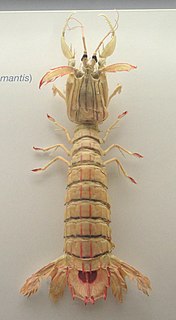Related Research Articles

Mantis shrimps, or stomatopods, are carnivorous marine crustaceans of the order Stomatopoda, branching from other members of the class Malacostraca around 340 million years ago. Mantis shrimps typically grow to around 10 cm (3.9 in) in length, while a few can reach up to 38 cm (15 in). The largest mantis shrimp ever caught had a length of 46 cm (18 in); it was caught in the Indian River near Fort Pierce, Florida, in the United States. A mantis shrimp's carapace covers only the rear part of the head and the first four segments of the thorax. Varieties range in color from shades of brown to vivid colors, with more than 450 species of mantis shrimps being known. They are among the most important predators in many shallow, tropical and subtropical marine habitats. However, despite being common, they are poorly understood, as many species spend most of their lives tucked away in burrows and holes.

Mantidae is one of the largest families in the order of praying mantises, based on the type species Mantis religiosa; however, most genera are tropical or subtropical. Historically, this was the only family in the order, and many references still use the term "mantid" to refer to any mantis. Technically, however, "mantid" refers only to members of the family Mantidae, and not the 14 remaining families of mantises. Some of the most recent classifications have promoted a number of the mantid subfamilies to the rank of family, e.g. Iridopterygidae, Sibyllidae, Tarachodidae, Thespidae, and Toxoderidae, while other classifications have reduced the number of subfamilies without elevating to higher rank.

Flower mantises are those species of praying mantises that mimic flowers. Their coloration is an example of aggressive mimicry, a form of camouflage in which a predator's colours and patterns lure prey. The flower mantises are not a natural group with a single ancestor, but most of the species are in the family Hymenopodidae. Their behaviours vary, but typically involve climbing a plant, and then staying still until a prey insect comes within range. Many species of flower mantises are popular as pets.

Squilla mantis is a species of mantis shrimp found in shallow coastal areas of the Mediterranean Sea and the Eastern Atlantic Ocean: it is also known as "pacchero" or "canocchia". Its abundance has led to it being the only commercially fished mantis shrimp in the Mediterranean.
Catasigerpes is a genus of praying mantis in the family Acromantinae.
Catasigerpes brunnerianus is a species of praying mantis in the genus Catasigerpes in the order Mantodea.
Catasigerpes camerunensis is a species of praying mantis in the genus Catasigerpes in the order Mantodea.
Catasigerpes congicus is a species of praying mantis in the genus Catasigerpes in the order Mantodea.
Catasigerpes erlangeri is a species of praying mantis in the genus Catasigerpes in the order Mantodea.
Catasigerpes granulatus is a species of praying mantis in the genus Catasigerpes in the order Mantodea.
Catasigerpes jeanneli is a species of praying mantis in the genus Catasigerpes in the order Mantodea.
Catasigerpes margarethae is a species of praying mantis in the genus Catasigerpes in the order Mantodea.
Catasigerpes mortuifolia is a species of praying mantis in the genus Catasigerpes in the order Mantodea.
Catasigerpes nigericus is a species of praying mantis in the genus Catasigerpes in the order Mantodea.
Catasigerpes occidentalis is a species of praying mantis in the genus Catasigerpes in the order Mantodea.
Catasigerpes toganus is a species of praying mantis in the genus Catasigerpes in the order Mantodea.
Catasigerpes zernyi is a species of praying mantis in the genus Catasigerpes in the order Mantodea.

Mantises are an order (Mantodea) of insects that contains over 2,400 species in about 430 genera in 30 families. The largest family is the Mantidae ("mantids"). Mantises are distributed worldwide in temperate and tropical habitats. They have triangular heads with bulging eyes supported on flexible necks. Their elongated bodies may or may not have wings, but all Mantodea have forelegs that are greatly enlarged and adapted for catching and gripping prey; their upright posture, while remaining stationary with forearms folded, has led to the common name praying mantis.
Epaphroditini is a tribe of the family Hymenopodidae. It has the following members:
References
- ↑ Tree of Life Web Project. 2005
| Wikispecies has information related to Catasigerpes acuminatus . |
 | This Hymenopodidae-related article is a stub. You can help Wikipedia by expanding it. |